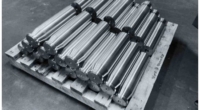RTLS technology, or real-time location system technology, is a dynamic digital alternative to traditional record-keeping and manual asset management. RTLS asset tracking and management is used across industries and sectors to monitor tools, production logistics, worker whereabouts, patient and staff location, and the progress of assembly lines. There are four main types of RTLS technology, including GPS, NFC, RFID, and WiFi, each with their own unique benefits and limitations. Most indoor environments require specific, complex, or intricate tracking setups, often involving more than one asset-tracking RTLS technology. The software used in RTLS technology will depend on the sensor and transmitter hardware and middleware that interprets the location data. The external application software and interface will be most vital for most businesses looking for useful RTLS asset management and tracking solutions. The best RTLS tracking software you use will accomplish your most important goals – scalability, API connectivity, analytics, practicality, ease of deployment and more.
A Comprehensive Overview of Real-Time Location Systems
Real-Time Location Systems (RTLS) are widely used in various industries including engineering, aerospace, manufacturing, and logistics. These industries face the challenge of tracking assets and people accurately and efficiently as they move through facilities. This challenge is especially heightened by the ongoing COVID-19 pandemic, which has led to the need for increased safety and protection of workers. Therefore, understanding RTLS technologies and their benefits is vital to improving efficiency, safety, and value.
RTLS technology tracks the geolocation of assets or people in real-time, creating a digital overview of a facility or plant. By deploying an RTLS system, companies can utilize real-time data to make informed decisions, improve productivity, and locate inefficiencies. This system also allows managers to isolate time-consuming tasks, misplaced assets, improper practices, shortfalls, inventory, and more. Active and passive RTLS assets can be affixed to stationary objects as well as those in motion.
Assets that can be tracked using RTLS technology include forklifts, vehicles, tools, hospital beds, cages, stillages and pallets, plane ramps, shipping containers, outdoor high-value assets, property or buildings, servers, drones or video equipment, ventilators, furniture, machinery, ID badges, access cards, and people.
There are several types of RTLS asset tracking technologies, and the right one to implement will depend on the size and complexity of your telemetry estate, as well as the types of assets you need to track. Some examples of RTLS asset technologies that can be used include:
Active RFID
Active RFID uses battery-powered tags that transmit signals to receivers. This technology is useful for tracking assets that are frequently moved or located in hard-to-reach areas.
Passive RFID
Passive RFID uses tags that are not battery-powered and require a receiver to be scanned. This technology is useful for tracking assets that are stationary or infrequently moved.
GPS
GPS technology utilizes satellites to track the location of assets. This technology is useful for tracking outdoor assets and vehicles that travel long distances.
Bluetooth Low Energy (BLE)
BLE is a wireless technology that uses low-energy Bluetooth signals to track assets. This technology is useful for tracking assets in indoor spaces and is commonly used in hospitals and warehouses.
In conclusion, Real-Time Location Systems (RTLS) technologies offer many benefits to various industries, including increased productivity, safety, and efficiency. By utilizing RTLS, companies can make informed decisions and locate inefficiencies in real-time, leading to cost savings and improved performance.
A Guide to Different Asset Tracking Technologies
Asset tracking is an essential tool used by various industries to keep track of assets and people accurately and efficiently. Asset tracking technologies, such as Bluetooth Low Energy (BLE), Ultra-Wideband (UWB), Radio-Frequency Identification (RFID), and WiFi asset tracking systems, play a vital role in achieving this goal.
Bluetooth Low Energy (BLE)
BLE is a short-range wireless communication technology that uses radio frequency tags and sensors to connect devices. Bluetooth tracking devices are highly accurate for smaller, more confined locations and can span areas up to 25m. BLE tags use very little power, making them cost-effective, but they are prone to interference.
Ultra-Wideband (UWB)
UWB tracking involves using ToF and TDoA signals to calculate a beacon’s position with exceptional accuracy down to the centimeter. UWB tags are battery-powered and work with sensors to provide real-time data into external asset management software. UWB tags use very little power with long-lasting batteries, making them highly advantageous for industrial applications.
Radio-Frequency Identification (RFID)
RFID systems use electromagnetic tags that contain ID data that can be read by readers. These systems can be passive or active. Active RFID tags are powered by internal batteries, while passive RFID tags rely on external power sources. RFID tags are compact, cost-effective, and long-lasting, but the signals can be prone to interception and less precise.
WiFi Asset Tracking Systems
WiFi asset tracking systems use existing WiFi networks to track the locations of authorized or enabled devices. These systems are highly versatile and can be extended beyond their standard range of 60-100m with the help of additional receivers or boosters.
In conclusion, the right asset tracking technology to implement will depend on the size and complexity of your telemetry estate, as well as the types of assets you need to track. BLE, UWB, RFID, and WiFi asset tracking systems all have their advantages and disadvantages. Choosing the right one for your business will help maximize efficiency, safety, and value.
Your Guide to Asset Tracking Technologies
Asset tracking technologies play a crucial role in tracking assets and people efficiently and accurately across various industries. Wi-Fi tracking, GPS asset tracking, Near Field Communication (NFC), and Real-Time Location Systems (RTLS) are some of the most popular asset tracking technologies used today.
Wi-Fi Tracking
Wi-Fi tracking is a cost-effective and straightforward setup that rarely requires data bridging systems. However, Wi-Fi tags often use significant power, which can be costly in the long run.
GPS Asset Tracking
GPS asset tracking is possible anywhere with unobstructed access to orbiting satellites. GPS works by triangulating the asset’s position based on the network of satellites, providing global visibility. However, GPS technology only works in outdoor environments and is therefore unreliable in facilities or terrain that obscures a line of sight with the satellites.
Near Field Communication (NFC)
NFC enables portable devices to communicate by bringing them close together. Enabled NFC devices read NFC tags, which are often embedded in stickers or labels. NFC does not rely on manual configuration, with compatible devices often connected autonomously and instantly. However, the read range is quite short and only suitable for applications with high density.
Real-Time Location Systems (RTLS)
RTLS technology tracks the geolocation of assets or people in real-time, creating a digital overview of a facility, factory, plant, or hanger. RTLS deployments rely on three core elements – transmitters, sensors, and software. The transmitters are either passive or active and are attached to an item or individual, which identify the asset and relay signals to sensors. The sensors, often connected to a power source and network, determine the location of each asset and relay the information to the software or visualization system. Most indoor environments require specific, complex or intricate tracking setups, often involving more than one asset-tracking RTLS technology.
Types of RTLS Technologies
-
Bluetooth Low Energy (BLE) – BLE is a short-range wireless communication technology that connects devices through radio frequency tags (or beacons) and sensors. BLE tracking devices are highly accurate for smaller, more confined locations.
-
Ultra-Wideband (UWB) – UWB tracking involves using Time of Flight (ToF) and Time Difference of Arrival (TDoA) signals to calculate a beacon’s position with exceptional accuracy down to the centimeter. UWB tags use very little power with long-lasting batteries, making them highly advantageous for industrial applications.
-
Radio-Frequency Identification (RFID) – RFID systems use electromagnetic tags that contain ID data that can be read by readers. These systems can be passive or active.
In conclusion, choosing the right asset tracking technology depends on the size and complexity of your telemetry estate, as well as the types of assets you need to track. Wi-Fi tracking, GPS asset tracking, NFC, and RTLS are all valuable tools for asset tracking, each with its own advantages and disadvantages. Understanding these technologies will help maximize efficiency, safety, and value in your business.
Real-Time Location Systems (RTLS) are becoming increasingly essential in the engineering, aerospace, manufacturing, and logistics sectors. Companies operating in these industries need to accurately and effectively track assets and people as they move through facilities, especially in the wake of the pandemic. Understanding RTLS technologies and their advantages is vital to maximizing efficiency, safety, and value.
RTLS technology tracks the geolocation of assets or people in real time, creating a digital overview of a facility or warehouse. RTLS can be implemented by deploying one or more of the following technologies: Bluetooth Low Energy (BLE), Ultra-Wideband (UWB), Radio-Frequency Identification (RFID), WiFi, GPS, and Near Field Communication (NFC).
BLE tracking systems have been widely used for decades and are highly accurate for smaller, more confined locations, usually areas that span up to 25m. UWB tracking setups are notorious for determining asset locations in three dimensions, which can be highly advantageous for industrial applications. RFID systems are an age-old technology that continues to prove valuable and reliable, with RFID asset tracking tags being long-lasting, compact and cost-effective. WiFi asset tracking systems use existing WiFi networks to track the locations of authorized or enabled devices.
All RTLS system deployments rely on three core elements: transmitters, sensors, and software. The transmitters identify the asset and relay signals to sensors. Depending on the tags used, the sensors will be distributed around the physical space, determining the location of each asset at any given time, and relaying this information to the software or visualization system.
The software associated with RTLS technology will depend on the sensor and transmitter hardware and middleware that interprets the location data. For most businesses looking for useful RTLS asset management and tracking solutions, the external application software and interface will be most vital.
There are numerous use cases for RTLS systems across industries and sectors. RTLS is a dynamic digital alternative to traditional record-keeping and manual asset management. There is no limit to RTLS functionality, but here are just a few examples to give you an idea of how an RTLS is used after its initial setup: aircraft, ship or vehicle assembly, facility or yard management, and healthcare premises.
Commercial or industrial IoT asset tracking technology can provide companies with real-time insights into processes and efficiency. Whether deploying an RTLS in an indoor, outdoor or hybrid environment, it’s understandable why many companies are choosing one or multiple technologies to ensure accurate and insightful real-time data is transmitted.
Don’t miss interesting posts on Famousbio










